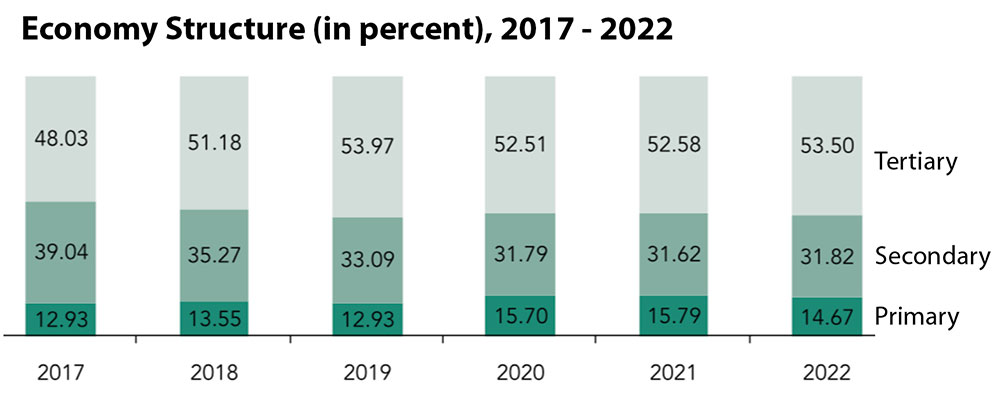YK Poudel
In 2022, Bhutan witnessed a growth in Gross Domestic Product (GDP) and Gross National Income (GNI) by 5.21 percent and 5.73 percent respectively. Nevertheless, there was a contraction of 1.15 percent in the contribution of the primary sector.
During 2022, the Gross Value Added (GVA) for the primary sector, encompassing agriculture, livestock, and forestry, experienced a decline of 1.15 percent, in contrast to the 1.42 percent growth observed in 2021.
This marked the first decline in this sector, following a drop of 2.57 percent the previous year.
However, the manufacturing (secondary) and service (tertiary) sectors made commendable contributions to GDP with growth rates of 5.6 percent and 6.62 percent, respectively.

The primary sector, encompassing activities like crop cultivation, livestock rearing, and forestry, faced a significant challenge. According to National Accounts Statistics 2023, crop production registered a negative growth rate of 4 percent in 2022, as opposed to a growth rate of 1.46 percent in 2021.
This decline of 5.46 percentage points from the previous year signifies a substantial decrease in its growth momentum.
The Integrated Agriculture and Livestock Census of Bhutan 2022 revealed that the production of primary cereals in 2022 was 70,168 metric tonnes, which was 6,319 metric tonnes less than in 2021, marking an eight percent decline.
In 2022, the primary sector contributed a value addition of Nu 15,521.92 million, slightly lower than the Nu 15,723.07 million recorded in 2021. The crop segment constituted approximately 6.81 percent of the GDP, underscoring its significance in the economy.
The livestock sector witnessed a growth of 0.31 percent in 2022, a decline from the 1.28 percent growth rate observed in 2021. Despite this, the livestock sector contributed only 0.02 percent to GDP growth last year. Nevertheless, the GVA for the livestock sector in 2022 was Nu 12,025.59 million, reflecting an increase in value addition compared to previous years.
Forestry and logging exhibited consistent growth over the past three years, achieving a growth rate of 4.07 percent in 2022, up from 1.65 percent in the previous year. This 2.42 percentage points increase from 2021 indicates a notable expansion in the sector, contributing 0.09 percentage points to the overall GDP growth in 2022.
According to the State of Forest Report 2023, forest coverage decreased from 71 percent in 2016 to 69.71 percent in 2022. The report attributes 95 percent of forest health disturbance to timber harvesting through selective felling.
In 2022, Bhutan experienced an increase in GDP, reaching Nu 23.15 billion, compared to Nu 227.81 billion in 2021 and Nu 204.66 billion in 2022.
In terms of its contribution to GDP, the agriculture (primary sector) sector accounted for 14.67 percent, the service sector contributed 53.5 percent, and the industry sector contributed 31.82 percent.
The GVA of the primary sector amounted to Nu 33,422.58 million in 2022, compared to Nu 32,326.30 million in 2021. As a share of the economy, the service sector held the highest share at 53.50 percent, followed by the secondary sector at 31.82 percent, and the primary sector at 14.67 percent.


